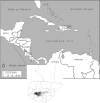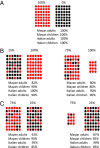Probabilistic cognition in two indigenous Mayan groups
- PMID: 25368160
- PMCID: PMC4260570
- DOI: 10.1073/pnas.1410583111
Probabilistic cognition in two indigenous Mayan groups
Abstract
Is there a sense of chance shared by all individuals, regardless of their schooling or culture? To test whether the ability to make correct probabilistic evaluations depends on educational and cultural guidance, we investigated probabilistic cognition in preliterate and prenumerate Kaqchikel and K'iche', two indigenous Mayan groups, living in remote areas of Guatemala. Although the tested individuals had no formal education, they performed correctly in tasks in which they had to consider prior and posterior information, proportions and combinations of possibilities. Their performance was indistinguishable from that of Mayan school children and Western controls. Our results provide evidence for the universal nature of probabilistic cognition.
Keywords: cognitive development; literacy; number cognition; numeracy; probabilistic cognition.
Conflict of interest statement
The authors declare no conflict of interest.
Figures




Comment in
-
Fuzzy universality of probability judgment.Proc Natl Acad Sci U S A. 2014 Dec 2;111(48):16984-5. doi: 10.1073/pnas.1420118111. Epub 2014 Nov 26. Proc Natl Acad Sci U S A. 2014. PMID: 25427799 Free PMC article. No abstract available.
References
-
- Locke J. An Essay Concerning Human Understanding. Penguin; London: 2004.
-
- De Finetti B. In: Foresight: Its Logical Laws, its Subjective Sources. Studies in Subjective Probability. Kyburg HE, Smokler HE, editors. Wiley; New York: 1937/1964. pp. 93–158.
-
- Von Mises R. Probability, Statistics and Truth. Allen & Unwin; London: 1957.
-
- Piaget J, Inhelder B. The Origin of the Idea of Chance in Children. Norton; New York: 1951/1975.
-
- Hallpike CR. The Foundations of Primitive Thought. Oxford Univ Press; Oxford: 1979.
Publication types
MeSH terms
LinkOut - more resources
Full Text Sources
Other Literature Sources

